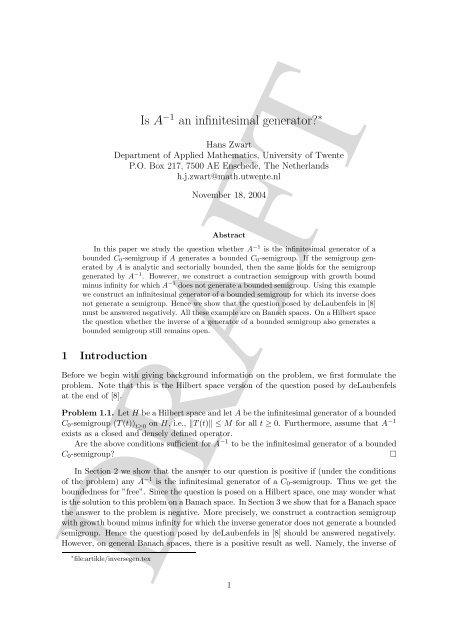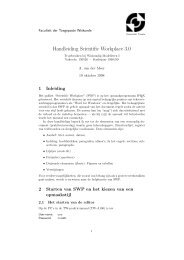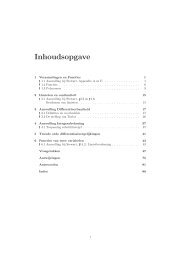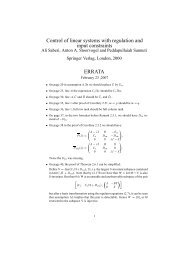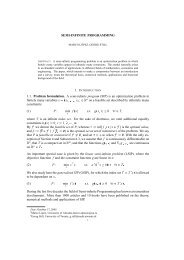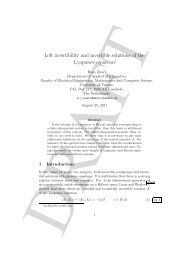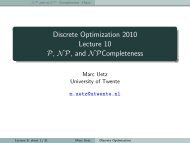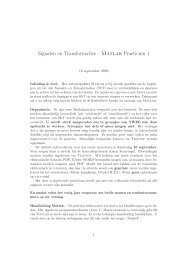Is Aâ1 an infinitesimal generator?â - Applied Mathematics
Is Aâ1 an infinitesimal generator?â - Applied Mathematics
Is Aâ1 an infinitesimal generator?â - Applied Mathematics
You also want an ePaper? Increase the reach of your titles
YUMPU automatically turns print PDFs into web optimized ePapers that Google loves.
<strong>Is</strong> A −1 <strong>an</strong> <strong>infinitesimal</strong> <strong>generator</strong>? ∗H<strong>an</strong>s ZwartDepartment of <strong>Applied</strong> <strong>Mathematics</strong>, University of TwenteP.O. Box 217, 7500 AE Enschede, The Netherl<strong>an</strong>dsh.j.zwart@math.utwente.nlNovember 18, 2004AbstractIn this paper we study the question whether A −1 is the <strong>infinitesimal</strong> <strong>generator</strong> of abounded C 0 -semigroup if A generates a bounded C 0 -semigroup. If the semigroup generatedby A is <strong>an</strong>alytic <strong>an</strong>d sectorially bounded, then the same holds for the semigroupgenerated by A −1 . However, we construct a contraction semigroup with growth boundminus infinity for which A −1 does not generate a bounded semigroup. Using this examplewe construct <strong>an</strong> <strong>infinitesimal</strong> <strong>generator</strong> of a bounded semigroup for which its inverse doesnot generate a semigroup. Hence we show that the question posed by deLaubenfels in [8]must be <strong>an</strong>swered negatively. All these example are on B<strong>an</strong>ach spaces. On a Hilbert spacethe question whether the inverse of a <strong>generator</strong> of a bounded semigroup also generates abounded semigroup still remains open.1 IntroductionBefore we begin with giving background information on the problem, we first formulate theproblem. Note that this is the Hilbert space version of the question posed by deLaubenfelsat the end of [8].Problem 1.1. Let H be a Hilbert space <strong>an</strong>d let A be the <strong>infinitesimal</strong> <strong>generator</strong> of a boundedC 0 -semigroup (T (t)) t≥0on H, i.e., ‖T (t)‖ ≤ M for all t ≥ 0. Furthermore, assume that A −1exists as a closed <strong>an</strong>d densely defined operator.Are the above conditions sufficient for A −1 to be the <strong>infinitesimal</strong> <strong>generator</strong> of a boundedC 0 -semigroup?□In Section 2 we show that the <strong>an</strong>swer to our question is positive if (under the conditionsof the problem) <strong>an</strong>y A −1 is the <strong>infinitesimal</strong> <strong>generator</strong> of a C 0 -semigroup. Thus we get theboundedness for ”free”. Since the question is posed on a Hilbert space, one may wonder whatis the solution to this problem on a B<strong>an</strong>ach space. In Section 3 we show that for a B<strong>an</strong>ach spacethe <strong>an</strong>swer to the problem is negative. More precisely, we construct a contraction semigroupwith growth bound minus infinity for which the inverse <strong>generator</strong> does not generate a boundedsemigroup. Hence the question posed by deLaubenfels in [8] should be <strong>an</strong>swered negatively.However, on general B<strong>an</strong>ach spaces, there is a positive result as well. Namely, the inverse of∗ file:artikle/inversegen.texDRAFT1
the <strong>generator</strong> of a sectorially bounded semigroup is again a <strong>generator</strong> of a sectorially bounded<strong>an</strong>alytic semigroup. This result originates from deLaubenfels, [8], but we present a new proof.In Section 4 we summarize some results on Problem 1.1. On Hilbert spaces it is not hard toshow that the <strong>an</strong>swer to our central problem is positive for the class of contraction semigroups.In the remaining of this section we discuss the motivation for our problem. The first motivationcomes from systems theory. Within infinite-dimensional systems theory one studiesthe following set of equations:ẋ(t) = Ax(t) + Bu(t) x(0) = x 0y(t) = Cx(t) + Du(t),where A : D(A) ⊂ H → H is the <strong>infinitesimal</strong> <strong>generator</strong> of a C 0 -semigroup on the Hilbertspace H, B is a bounded linear operator from the Hilbert space U to the dual of the domainof A ∗ , i.e., B ∈ L(U, D(A ∗ ) ′ ), C ∈ L(D(A), Y ), where Y is a third Hilbert space, <strong>an</strong>dD ∈ L(U, Y ). In [1], Ruth Curtain introduced the following related system:ẋ 1 (t) = A −1 x 1 (t) + A −1 Bu 1 (t)y 1 (t) = −CA −1 x 1 (t) + (D − CA −1 B)u 1 (t).This system has the nice property that A −1 B ∈ L(U, H), CA −1 ∈ L(H, Y ). Hence this systemis a bounded linear systems as studied in Curtain <strong>an</strong>d Zwart [2]. Furthermore, the systems(1) <strong>an</strong>d (2) share m<strong>an</strong>y properties. For inst<strong>an</strong>ce, (1) is input-state stable if <strong>an</strong>d only if (2)is. Here input-state stability me<strong>an</strong>s that for all inputs u ∈ L 2 ((0, ∞); U) the solution of (1)exists <strong>an</strong>d is (uniformly) bounded on [0, ∞).The only stability property which is not known is the state-state stability, i.e., if thesemigroup generated by A is (strongly) stable if <strong>an</strong>d only if the semigroup generated by A −1(strongly) stable. It is not hard to show that this property holds if the <strong>an</strong>swer to our problemis positive, see also Grabowski <strong>an</strong>d Callier [5].The second motivation for our problem comes from numerical <strong>an</strong>alysis. Consider the(abstract) differential equationẋ(t) = Ax(t), x(0) = x 0 . (3)A st<strong>an</strong>dard method for solving this differential equation is by using Cr<strong>an</strong>k-Nicolson method.In this method the differential equation (3) is replaced by the difference equationx d (n + 1) = (I + ∆A/2)(I − ∆A/2) −1 x d (n), x d (0) = x(0), (4)where ∆ is the time step.If H is finite-dimensional, <strong>an</strong>d thus A is a matrix, then it is easy to show that the solutionsof (3) are bounded if <strong>an</strong>d only if the solutions of (4) are bounded. Or equivalently,if <strong>an</strong>d only ifsup ‖e At ‖ =: M c < ∞t≥0DRAFTsup ‖A n d ‖ =: M d < ∞,n∈N2(1)(2)
where A d = (I + ∆A/2)(I − ∆A/2) −1 . However, the best estimates for M d are dependingon M c <strong>an</strong>d the dimension of H, see [4]. In Guo <strong>an</strong>d Zwart [6] the following estimate wasobtained,M d = sup ‖A n d ‖ ≤ 2 · e(M c 2 + M c,−1 2 ), (5)where M c,−1 = sup ‖e A−1t ‖.t≥0n∈NIt is not hard to show that if the <strong>an</strong>swer to our problem is positive, then M c1 −1 is a functionof M c only, <strong>an</strong>d thus by (5) M d becomes a function of M c only. We close this section withthe remark that (5) holds for <strong>an</strong>y Hilbert space, <strong>an</strong>d so if A generates a bounded semigroup<strong>an</strong>d if the <strong>an</strong>swer to our problem is positive, then the solutions of the difference equation (4)are bounded.2 Equivalent formulation of the problemIn this section we consider the following weaker formulation of Problem 1.1.Problem 2.1. Let H be a Hilbert space <strong>an</strong>d let A be the <strong>infinitesimal</strong> <strong>generator</strong> of a boundedC 0 -semigroup (T (t)) t≥0on H, i.e., ‖T (t)‖ ≤ M for all t ≥ 0. Furthermore, assume that A −1exists as a closed <strong>an</strong>d densely defined operator.Are the above conditions sufficient for A −1 to be the <strong>infinitesimal</strong> <strong>generator</strong> of a C 0 -semigroup?□Hence the difference between Problem 1.1 <strong>an</strong>d Problem 2.1 is that we do not requirethat the semigroup generated by A −1 is bounded. It is clear that if Problem 1.1 holds, thenProblem 2.1 holds. In the following theorem we show that both problems are equivalent.Note that this does not me<strong>an</strong> that for <strong>an</strong>y A for which A −1 generates a C 0 -semigroup, thissemigroup will be bounded. It merely me<strong>an</strong>s that if the <strong>an</strong>swer to Problem 2.1 is positive forall A’s <strong>an</strong>d all Hilbert spaces, then the <strong>an</strong>swer to Problem 1.1 is positive as well.Theorem 2.2. If Problem 2.1 holds for A’s <strong>an</strong>d all Hilbert spaces, then Problem 1.1 holdsas well.Proof. Assume that A generates a bounded semigroup (T (t)) t≥0, <strong>an</strong>d that A −1 exists as aclosed <strong>an</strong>d densely defined operator. Since Problem 2.1 holds, we conclude that A −1 generatesa C 0 -semigroup S(t). It remains to show that this semigroup is bounded. In order to do this,we introduce the Hilbert space H ext aswith the norm∥ ∥∥∥∥∥∥⎛⎜⎝x 1x 2.H ext = H ⊕ H ⊕ . . .⎞⎟∑⎠= √ ∞ ‖x n ‖ 2 H . (6)∥ n=1HextDRAFTOn H ext we consider the operator A ext = diag (n −1 A). It is easy to see that this generatesthe C 0 -semigroup ( diag ( T (n −1 t) )) t≥0 . Since (T (t)) t≥0is bounded this semigroup whichis bounded. The operator A ext has as inverse diag (nA −1 ). By the conclusion of Problem2.1 this generates a C 0 -semigroup. It is not hard to see that this semigroup is given by3
(diag (S(nt))) t≥0 . Since a C 0 -semigroup is uniformly bounded on every compact interval,<strong>an</strong>d since for all t ≥ 0‖diag (S(nt))‖ = sup ‖S(nt)‖,we conclude thatsup ‖S(t)‖ = sup sup ‖S(nt)‖ = sup ‖diag (S(nt))‖ < ∞.t≥0t∈[0,1]Thus we have proved the theorem.nnt∈[0,1]Remark 2.3. Note that if the space H in the above theorem is a B<strong>an</strong>ach space, then thespace H ext is a B<strong>an</strong>ach space as well. Thus the same theorem holds on a B<strong>an</strong>ach space.3 e A−1t on a B<strong>an</strong>ach spaceIn this section we show that the <strong>an</strong>swer to our problem is negative if we would relax ourassumption on the space. That is, if we would consider the problem on a B<strong>an</strong>ach space.However, before we present these negative results, we show that the <strong>an</strong>swer is positive if Agenerates a (sectorially) bounded <strong>an</strong>alytical semigroup. From Theorem 2.5.2 of [9] we recallthat A generates a (sectorially) bounded <strong>an</strong>alytical semigroup, (‖T (t)‖ ≤ M for all t ∈ Cwith | arg(t)| < θ, θ > 0) if <strong>an</strong>d only if‖(sI − A) −1 ‖ ≤ M |s|for arg(s) < π/2 + θ. (7)Using this characterization it is easy to prove that A −1 generates a sectorially bounded <strong>an</strong>alyticsemigroup if <strong>an</strong>d only if A does.Theorem 3.1. Let A be the <strong>generator</strong> of a sectorially bounded <strong>an</strong>alytic semigroup <strong>an</strong>d letA −1 exist as a closed, densely defined operator. Then A −1 generates a sectorially bounded<strong>an</strong>alytic semigroup.Proof. Choose s ∈ C \ {0} with argument less th<strong>an</strong> π 2 + θ.Taking the inverse, we get(sI − A −1 ) =(A − 1 )s I · s · A −1((sI − A −1 ) −1 = A A − 1 ) −1s I · 1s=(A − 1 s I + 1 ) (s I A − 1 ) −1s I · 1s= 1 s + 1 s 2 (A − 1 s I ) −1. (8)DRAFT4
Since arg(s −1 ) = − arg(s), we may use our estimate for the resolvent of A, <strong>an</strong>d we obtain forall s ∈ C \ {0} with argument less th<strong>an</strong> π 2 + θ∥‖(sI − A −1 ) −1 ‖ ≤ 1|s| + 1 ∥∥∥∥ (A|s| 2 − 1 ) ∥−1∥∥∥∥s I≤ 1|s| + 1|s| 2 · M| 1 s |= M + 1 .|s|Using theorem Theorem 2.5.2 of [9], we conclude that A −1 generates a sectorially bounded<strong>an</strong>alytic semigroup.In the rest of this section the following function will play <strong>an</strong> import<strong>an</strong>t role.h ac (t) = 1 √tJ 1 (2 √ t), (9)where J 1 (·) is the Bessel function of the first kind <strong>an</strong>d of the first order.properties c<strong>an</strong> be found in the literature, see e.g. Watson [10];The followinga. h ac (·) is continuous on (0, ∞), <strong>an</strong>d continuous from the right at zero with limit one.b. h ac (·) is bounded by one on [0, ∞).c. For large t, we haveh ac (t) ≈ √ 1 t − 3 4 cos(2 √ t − 3 π 4 π).d. The function h ac (·) is the derivative of −J 0 (2 √ t), where J 0 is the Bessel function of thefirst kind <strong>an</strong>d of the zeroth order.Furthermore, using property d. <strong>an</strong>d [3], we have that∫ ∞Using this equation we c<strong>an</strong> prove the following lemma.0e −st h ac (t)dt = 1 − e −1/s . (10)Lemma 3.2. Let A generate <strong>an</strong> exponentially stable C 0 -semigroup (T (t)) t≥0on the B<strong>an</strong>achspace X. Then the following equality holdse A−1τ x 0 = x 0 −∫ ∞0τh ac (tτ)T (t)x 0 dt. (11)Proof. Since T (t) is exponentially ( ) stable, A −1 exists as a bounded operator. Thus it generatesthe C 0 -semigroup e A−1 t. Furthermore, combining the exponential stability withproperty b., we see that the integral in (11) is well-defined.DRAFTt≥05
To show the equality in (11) we take the Laplace-tr<strong>an</strong>sform on both sides. The Laplacetr<strong>an</strong>sform of e A−1τ x 0 equals (sI −A −1 ) −1 x 0 , whereas the Laplace tr<strong>an</strong>sform of x 0 equals x 0 /s.Thus it remains to calculate the Laplace tr<strong>an</strong>sform of the integral term in (11).∫ ∞[∫ ∞]e −sτ τh ac (tτ)T (t)x 0 dt dτ00∫ ∞[∫ ∞]=e −sτ τh ac (tτ)dτ T (t)x 0 dt, using Fubini0 0∫ ∞[∫ ∞=e − s t ˜τ 1 ]0 0 t 2 ˜τh ac(˜τ)d˜τ T (t)x 0 dt ˜τ = tτ∫ ∞[ ∫ d ∞= −e − s 1t ˜τ h ac (˜τ)d˜τ]0 ds 0t T (t)x 0dt∫ ∞[ ] d 1= −0 ds (1 − e−t/s )t T (t)x 0dt by (10)∫ ∞=[e −t/s 1 ]s 2 T (t)x 0 dt0= 1 s 2 ( 1s I − A ) −1x 0 .Using equation (8) we have that the Laplace tr<strong>an</strong>sform of the right-h<strong>an</strong>d side of (11) is equalto1s x 0 − 1 ( ) 1 −1s 2 s I − A x 0 = ( sI − A −1) −1x0which proves the lemma.Under the assumption that A generates <strong>an</strong> exponentially stable semigroup, the abovelemma gives the relation between the semigroups generated by A −1 <strong>an</strong>d A. Since the semigroupgenerated by A is exponentially stable, A −1 is a bounded operator, <strong>an</strong>d thus it isthe <strong>infinitesimal</strong> <strong>generator</strong> of a C 0 -semigroup. Using convergence results of semigroups, itis not hard to show the following. Let A be the <strong>infinitesimal</strong> <strong>generator</strong> of a bounded semigroup.∫Then A −1 is the <strong>infinitesimal</strong> <strong>generator</strong> of a C 0 -semigroup if <strong>an</strong>d only if the limit of∞0τh ac (tτ)e −εt T (t)x 0 dt for ε ↓ 0 exists for all x ∈ X.( )Using the formula (11), we c<strong>an</strong> show that in general e A−1 tis not (uniformly) bounded.However, on the domain A, we have that this semigroup converges to zero.Theorem 3.3. Let A be the <strong>infinitesimal</strong> <strong>generator</strong> of <strong>an</strong> exponentially stable semigroup(T (t)) t≥0on the B<strong>an</strong>ach space X. Then the following holdsa. If ‖T (t)‖ ≤ Me −ωt , with M, ω > 0, then for x 0 ∈ D(A) we haveb. For x 0 ∈ D(A), we have thatt≥0‖e A−1t x 0 ‖ ≤ M ω ‖Ax 0‖. (12)DRAFTlimt→∞ eA−1t x 0 = 0. (13)6
Proof. We begin by studying the integral term in (11). Substituting ˜t = tτ is this term gives∫ ∞0∫ ∞( ) ˜tτh ac (tτ)T (t)x 0 dt = h ac (˜t)T x 0 d˜t0τ) ( ) ∣ ˜t ∣∣∣∞ ∫ ∞ ) ( ) 1 ˜t= −J 0(2√˜t T x 0 + J 0(2√˜tτ0 0τ T Ax 0 d˜tτ∫ ∞ ) ( ) 1 ˜t= x 0 + J 0(2√˜tτ T Ax 0 d˜t,τ0where we have used property d. <strong>an</strong>d the fact that J 0 (0) = 1, J 0 (∞) = 0. So we have thate A−1τ x 0 = −∫ ∞0) ( ) 1 ˜tJ 0(2√˜tτ T Ax 0 d˜t (14)τSince the Bessel function J 0 is bounded by one on the positive real line, we c<strong>an</strong> bound thesemigroup generated by A −1 as‖e A−1τ x 0 ‖ ≤∫ ∞01τ Me− ω ˜t τ ‖Ax 0 ‖d˜t = M ω ‖Ax 0‖,which proves (12).In order to prove part b., we use that fact that there exists a t 1 > 0 such that |J 0 (2 √˜t)| ≤1 ˜t π −1/4 for ˜t > t 1 , see Watson [10, p. 199]. Using (14) we have‖e A−1τ x 0 ‖≤∫ t101τ M‖Ax 0‖d˜t += Mt 1‖Ax 0 ‖ +τ= Mt 1‖Ax 0 ‖ +τ≤ Mt 1‖Ax 0 ‖ + M τπ∫ ∞1∫ ∞t 11t∫ 1∞t 1 /τπ ˜t −1/4 1 τ Me− ω τ ˜t ‖Ax 0 ‖d˜tπ ˜t −1/4 1 τ Me− ω ˜t τ ‖Ax 0 ‖d˜tMπ t−1/4 τ −1/4 e −ωt ‖Ax 0 ‖dt1τ 1/4 ‖Ax 0‖∫ ∞0t −1/4 e −ωt dt.From this it is clear that ‖e A−1τ x 0 ‖ converges to zero for τ going to infinity.So we see that the semigroup generated by A −1 is uniformly bounded on the domain of A.In the next theorem we estimate this semigroup on the B<strong>an</strong>ach space, <strong>an</strong>d find it is boundedby a const<strong>an</strong>t times ( t 1/4 ) . In Example 3.5 we show that this bound is the best possible. Thusthe semigroup e A−1 tneeds not to be bounded, even when (T (t)) t≥0is exponentiallyt≥0stable.Theorem 3.4. Let A be the <strong>infinitesimal</strong> <strong>generator</strong> of a exponentially stable semigroup(T (t)) t≥0on the B<strong>an</strong>ach space X. Then for t ≥ 0 there exists <strong>an</strong> M 0 > 0 such thatDRAFT‖e A−1t ‖ ≤ 1 + M 0 t 1 4 . (15)7
Proof. We again concentrate on the integral term in (11). We have that, using property c.,∫ ∞0‖τh ac (tτ)T (t)x 0 ‖dt≤≤∫ ∞0∫ ∞Mτ|h ac (tτ)|Me −ωt ‖x 0 ‖dt0M 2= MM 2 ‖x 0 ‖τ 1 4τ(tτ) 3/4 e−ωt ‖x 0 ‖dt∫ ∞= MM 2 ‖x 0 ‖τ 1 π √ 24ω 1 4 Γ( 3 4 ).Combining this inequality with equation (11), we see that (15) holds.01t 3/4 e−ωt dtExample 3.5. In our example we take X = C 0 (0, 1), i.e., the space of all continuous functionson [0, 1), which have limit zero at one. This is a B<strong>an</strong>ach space under the supremum norm.On this state space we choose as semigroup{f(t + η) t + η ∈ [0, 1)(T (t)f) (η) =(16)0 t + η ≥ 1It is not hard to see that this is a strongly continuous semigroup on X with ‖T (t)‖ ≤ 1, <strong>an</strong>dT (t) = 0 for t ≥ 1. So it is a contraction semigroup with growth bound minus infinity. Inparticular, the semigroup is exponentially stable.From Lemma 3.2 we have that( )∫ 1−ηe A−1τ f (η) = f(η) − τh ac (tτ)f(t + η)dt= f(η) −0∫ (1−η)τ0( ) ˜th ac (˜t)fτ + η d˜t. (17)By constructing a suitable sequence of functions f’s, we show that ‖e A−1τ ‖ behaves like 4√ τ.Therefore we fix τ.Let φ ε be a continuous function on R which is positive, bounded by one, φ ε (0) = 0, <strong>an</strong>dφ ε (t) = 1 for |t| ≥ ε. Furthermore, define ψ τ be a continuous function on [0, ∞) which ispositive, bounded by one, ψ τ (t) = 0 for t ≥ τ, <strong>an</strong>d ψ τ (t) = 1 for t < τ − 1.Let t k , k = 1, . . . , K be the zeros of h ac in [0, τ].[ K]∏g ε (t) = φ ε (t − t k ) sign(h ac (t))ψ τ (t), t ≥ 0.k=1It is not hard to see that g ε is continuous on [0, ∞) with g ε (t) = 0 for t ≥ τ <strong>an</strong>d sup t≥0 |g ε (t)| =1. Hence f(t) := −g ε (t/τ) is <strong>an</strong> element of X with norm one.Next choose in equation (17) η = 0 <strong>an</strong>d f(t) = −g ε (τt), then( )∫ τ( ) ˜te A−1τ f (0) = f(0) − h ac (˜t)f0 τ + 0 d˜t∫≥ f(0) +|h ac (˜t)|d˜t.DRAFT{˜t∈[0,τ−1]||˜t−t k |≥ɛ, for k=1,...K}8
Since f has norm one, we see that∫‖e A−1τ ‖ ≥ 1 + sup= 1 +ε>0 {˜t∈[0,τ−1]||˜t−t k |≥ɛ, for k=1,...K}∫ τ−10|h ac (˜t)|d˜t|h ac (˜t)|d˜t. (18)By property c. we find that this is of the order τ 1/4 . So for the exponentially stable semigroup(16) the semigroup generated by A −1 is not uniformly bounded.As one c<strong>an</strong> see from the above proof, it would simplify a lot if we could choose f(t) =h ac (tτ). However, since the sign function is not continuous, we have to approximate it withcontinuous functions.Remark 3.6. The technique of Theorem 3.4 <strong>an</strong>d Example 3.5 c<strong>an</strong> be used to prove a moregeneral result. Let h : [0, ∞) → R be locally integrable. Then the tr<strong>an</strong>sformation:H(A, τ)x 0 =∫ ∞0τh(tτ)T (t)x 0 dtgives for every exponentially stable C 0 -semigroup T (t) <strong>an</strong> uniformly bounded operator-valuedfunction if <strong>an</strong>d only if h is absolutely integrable. Furthermore, we have that‖H(A, τ)‖ ≤∫ ∞For more information, see also Chapter XV of [7].0|h(t)|dt · sup ‖T (t)‖.Using Example 3.5 <strong>an</strong>d Remark 2.3 it is easy to construct <strong>an</strong> example of a bounded C 0 -semigroup for which A −1 does not generate a C 0 -semigroup. This example shows that thequestion posed by deLaubenfels in [8] must be <strong>an</strong>swered negatively.Example 3.7. Let X = C 0 (0, 1) be the B<strong>an</strong>ach space of Example 3.5 <strong>an</strong>d let (T (t)) t≥0bethe shift semigroup of the same example <strong>an</strong>d let A be its <strong>infinitesimal</strong> <strong>generator</strong>. By (S(t)) t≥0we denote the semigroup generated by A −1 . The B<strong>an</strong>ach space X ext is defined aswith the norm∥ ∥∥∥∥∥∥⎛⎜⎝x 1x 2.t≥0X ext = X ⊕ X ⊕ . . .⎞⎟∑⎠= √ ∞ ‖x n ‖ 2 X .∥ n=1XextOn X ext we consider the operator A ext = diag (n −1 A). It is easy to see that this generatesthe C 0 -semigroup (T ext (t)) t≥0:= ( diag ( T (n −1 t) )) t≥0 . Using the fact that (T (t)) t≥0 is acontraction semigroup, it is easy to show that (T ext (t)) t≥0 is a contraction semigroup on X ext .If A −1ext would be the <strong>generator</strong> of a C 0-semigroup, then this semigroup would be given by(diag (S(nt))) t≥0. Since a semigroup is bounded on every compact interval, we findsup ‖S(t)‖ = sup sup ‖S(nt)‖ = sup ‖diag (S(nt))‖ < ∞.t≥0DRAFTt∈[0,1]nt∈[0,1]However, we known from Example 3.5 that (S(t)) t≥0is not uniformly bounded. Hence A −1extis not the <strong>infinitesimal</strong> <strong>generator</strong> of a C 0 -semigroup.9
4 e A−1t on a Hilbert spaceOn Hilbert spaces there is, apart from the class of (sectorially) bounded <strong>an</strong>alytic semigroups,a second class of <strong>generator</strong>s for which our problem has been solved. This is the class of<strong>infinitesimal</strong> <strong>generator</strong>s of contraction semigroups. It is well known that A is the <strong>infinitesimal</strong><strong>generator</strong> of a contraction semigroup on the Hilbert space H if <strong>an</strong>d only if Re〈x, Ax〉 ≤ 0for all x ∈ D(A) <strong>an</strong>d (λI − A) is invertible for some λ > 0. Using this, the following lemmafollows almost directly.Lemma 4.1. Let A be the <strong>infinitesimal</strong> <strong>generator</strong> of a contraction semigroup on the Hilbertspace H <strong>an</strong>d assume that A −1 exists as a closed, densely defined operator. Then A −1 is alsothe <strong>infinitesimal</strong> <strong>generator</strong> of a contraction semigroup.Proof. Since the domain of A −1 equals the r<strong>an</strong>ge of A, we have to study the inner productof A −1 x with x for x in the r<strong>an</strong>ge of A. Since these elements c<strong>an</strong> be written as Ay, withy ∈ D(A), we find thatRe 〈x, A −1 x〉 = Re 〈Ay, y〉Since by assumption this last expression is positive, we see that A −1 satisfies one of thecondition. Furthermore, it is easy to show that (λI − A −1 ) is boundedly invertible for someλ > 0, see e.g. (8). Hence A −1 is the <strong>infinitesimal</strong> <strong>generator</strong> of a contraction semigroup onH.Since on a Hilbert space, m<strong>an</strong>y bounded semigroups are similar to a contraction semigroup,we see that on Hilbert spaces the <strong>an</strong>swer to our problem is yes in m<strong>an</strong>y cases. One case ofparticular interest is the class of bounded groups, see [12]. However, it is unknown whetherthe problem holds for <strong>an</strong>y semigroup on a Hilbert space.References[1] R.F. Curtain, Regular linear systems <strong>an</strong>d their reciprocals: applications to Riccati equations,Systems <strong>an</strong>d Control Letters, 49, pp. 81–89, 2003.[2] R.F. Curtain <strong>an</strong>d H.J. Zwart, An introduction to Infinite-Dimensional Linear SystemsTheory, Springer-Verlag, New York, 1995.[3] G. Doetsch, Introduction to the Theory <strong>an</strong>d Application of the Laplace tr<strong>an</strong>sformation,Springer Verlag, Berlin, 1970.[4] J.L.M. v<strong>an</strong> Dorsselaer, J.F.B.M. Kraaijev<strong>an</strong>ger, <strong>an</strong>d M.N. Spijker, Linear stability <strong>an</strong>alysisin the numerical solution of initial value problems, Act Numerica, pp. 199–237, 1993.[5] P. Grabowski <strong>an</strong>d F.M. Callier, On the Circle Criterion for Boundary Control Systemsin Factor Form: Lyapunov stability <strong>an</strong>d Lur’e equations, Report 2002/05, Departmentof <strong>Mathematics</strong>, University of Namur (FUNDP), April 2002[6] B.Z. Guo <strong>an</strong>d H. Zwart, On the relation between stability of continuous- <strong>an</strong>d discretetimeevolution equations via the Cayley tr<strong>an</strong>sform, IOET, (to appear).DRAFT[7] E. Hille <strong>an</strong>d R.S. Phllips, Functional Analysis <strong>an</strong>d Semigroups, AMS Providence R.I.,1957.10
[8] R. deLaubenfels, Inverses of <strong>generator</strong>s, Proc. AMS., 104(2) (1988), 443-448.[9] A. Pazy, Semigroups of Linear Operators <strong>an</strong>d Applications to Partial Differential Equations,Springer Verlag 1983.[10] G.N. Watson, Theory of Bessel Functions, second edition, Cambridge, 1962.[11] H. Zwart, B. Jacob <strong>an</strong>d O. Staff<strong>an</strong>s, Weak admissibility does not imply admissibility for<strong>an</strong>alytic semigroups, Systems & Control Letters, 48, (2003), 341–350.[12] H. Zwart. On the invertibility <strong>an</strong>d bounded extension of C 0 -semigroups. SemigroupForum, 63(2):153–160, 2001.DRAFT11


